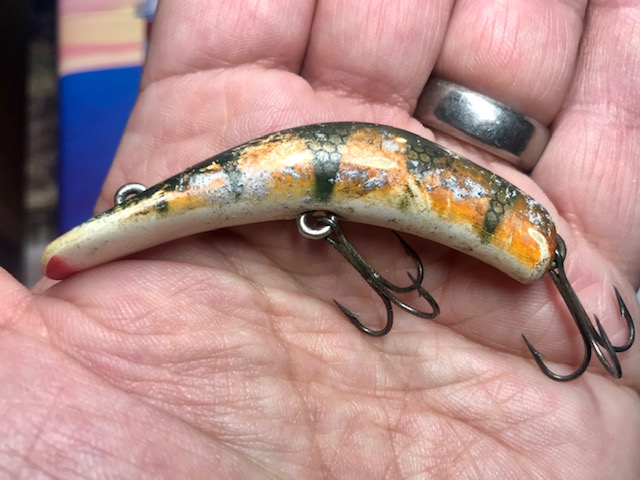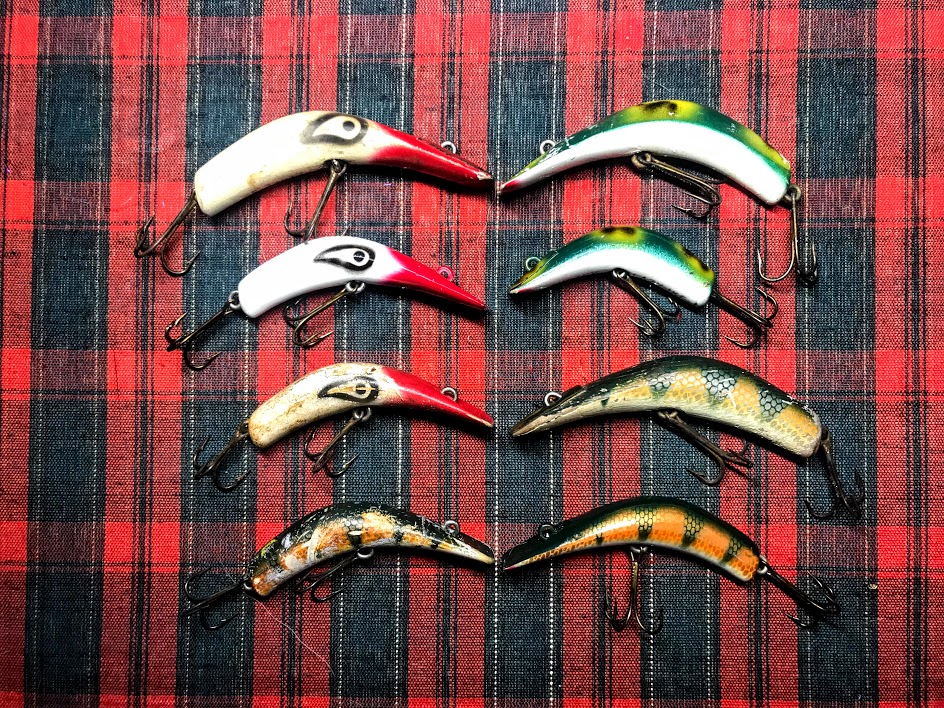 I’m trying to remember when the last time was that I had one tied on. A Lazy Ike that is. When I was a kid, these were the go-to bass lures for our haunts.
I’m trying to remember when the last time was that I had one tied on. A Lazy Ike that is. When I was a kid, these were the go-to bass lures for our haunts.
I look at my meager collection of Lazy Ikes, and they invoke these feelings that I can’t quite describe. Feelings of happiness, thinking about how a ten-year-old version of me viewed a Lazy Ike hanging from my rod tip, how it represented so much hope and anticipation, and at the same time a nostalgic sadness for days gone by. Feelings way stronger than a grown man should have over some old fishing lures.
Bass fishing for me when I was a kid was different then what most people picture when they think of bass fishing. Grandpa [we all called him Phred] took me fishing where he and his son [my uncle] had fished starting in the 50’s. A quick trip east on 94 brings you across the St Croix River and into St Croix County, the place where I did most of my fishing between the ages of 5 and 15. Head north from the freeway and you’re bound to run into the Willow River. Over 100 years ago dams were built on this [and every other] river, creating some small lakes. These lakes provided great fishing in the 50’s and to a lesser extent now. On every car ride over Phred would regale me with tales of years gone by, times when the bass would fight each other over a frog-colored Lazy Ike, where so many bass were caught they didn’t know what to do with them all. “They were all five-pounders!” was often how a story would end. No wonder I often got restless while we were bobber fishing for sunnies– I was eyeing the far shoreline, thinking there must be at least one five pounder left for me…
Here’s Phred with one
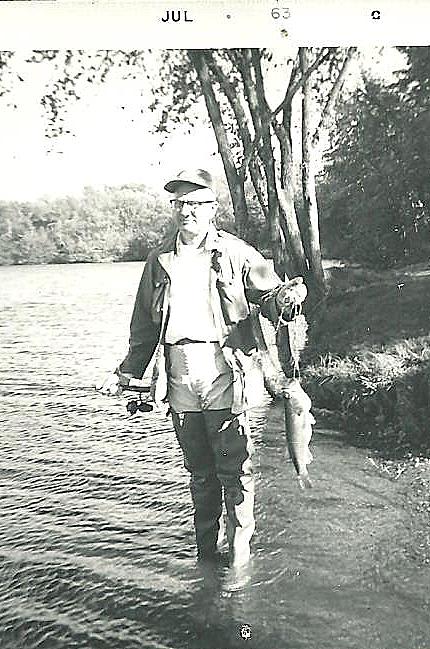
This must have been a slow day–there’s only one on the stringer
There was no boat. Phred never owned a boat, never got in a boat, got nervous if he saw a boat. We mostly fished for panfish around the dams or trout in area streams. On a good day I could talk Grandpa into bass fishing. So, clad in hip boots, we made our way along the dirt foot paths that followed most undeveloped shorelines. Our rods were standard fiberglass spinning rods from the 60’s [ at least a couple were Heddons], the reels were Johnson Citation push button reels. These reels are meant to be used on the top of the rod, but Phred learned a way to convert them so they would hang under a spinning rod. Tangle free, but otherwise awful, this was what we used, as he was very skeptical of open-face spinning reels. Quick to point out the abundant poison ivy, Phred would lead the way and we would gingerly step in at various openings in the trees. Knee-deep, the fan-casting process would begin. First make a couple short casts straight out. This cast rarely got a strike. The 45 degree angle casts were more likely to produce, but it was the casts that would be nearly parallel to the bank that were “money”. A steady straight retrieve was all that was needed to get the Lazy Ike to dance. We really liked the frog pattern Ike, and I remember once when we lost a favorite frog-colored one to a snag. Anyone whoever fished with Phred can relate to how losing a lure to him was almost as bad as losing a family member. I remember the days we caught bass doing this, and I have forgotten all the days we didn’t. We didn’t really grasp seasonal movements of fish, and I’m sure that the productive trips were all in the spring or early summer.
Bass that were unfortunate enough to fall for the siren song of the Lazy Ike always ended up on the stringer. We never really caught that many; any day where at least one was caught was a success. Grandpa was not a believer in catch and release, and on a good day there could be several largemouths on the chain when we got back to the station wagon where our catch would be bagged and deposited in the green cooler.
If you’ve never used a Lazy Ike, you probably didn’t do any fishing before 1980. This lure style dominated the fishing scene from the 50’s through the 70’s, and for good reason. They cast well and have a very enticing wobble even at slow speeds. They dive down to about 3 or 4 feet and are known to catch all types of predatory fish. Why aren’t they used anymore? Or better question, why don’t I use them anymore? I think that when a Bass Pro Shops Catalog found its way into my house when I was about 14 and I became aware of things like Rebel crankbaits and Mann’s Jelly Worms that my taste in bass lures changed.
Check out how prominently Lazy Ikes were featured in this great old book, “Minnesota Fish and Fishing” by Kit Berg. I somehow ended up with a first edition from 1958.
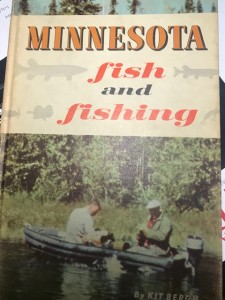

The only negative thing I can think of about these lures is that they were notoriously hard to keep “in-tune” [to non-anglers, this means keep them running straight]. Bounce one off a rock too hard, or catch too many fish on one and the next thing you know the lure is riding up to the surface on the retrieve instead of doing its “cha-cha” dance in front of a fish’s face. Bending the line-tie slightly [very slightly] in the opposite direction that the out of tune lure is running will usually get it running straight again. Usually. I can remember times where the air turned blue around my grandpa as he got creative with words describing a Lazy Ike that he couldn’t get to run straight.
My love for Lazy Ikes never completely went away. In more recent history, but still a couple of lifetimes ago, I resurrected some of my old Ikes as I found them to be effective for casting for walleyes in the spring or fall from shore. You can reel these things SLOW and they still have great action. Reeling into current you can go even slower. This was when I lived up north. I even bought some new ones at some point, but found that the quality had fallen way off. I took a friend with me one crisp fall evening. We parked near a bridge that crossed the Upper Mississippi where I had been regularly catching a few walleyes each session. He wanted to use a Rapala, but I insisted he rig up with a beat-up Lazy Ike. The streetlights 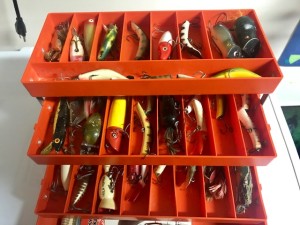 illuminated the rocky path, and cast an eerie glow on the river. I instructed Gunnar exactly where to cast: at an angle to shore, right along a shadow line. He made the first cast straight out. “NO! Cast it THERE!” as I pointed out the money cast. He dutifully reeled up the red and white Ike and casted as instructed. Three cranks of the handle and our dinner was on the line. After he set the hook, he gave me a knowing glance and said “always listen to the guide…” We could see its eyes glowing in the streetlight haze before we could see the fish, and before long we had two more, each one between two and three pounds. Every one of them hit the same red and white Ike while it was being reeling in slowly against the current. We ate well that night.
illuminated the rocky path, and cast an eerie glow on the river. I instructed Gunnar exactly where to cast: at an angle to shore, right along a shadow line. He made the first cast straight out. “NO! Cast it THERE!” as I pointed out the money cast. He dutifully reeled up the red and white Ike and casted as instructed. Three cranks of the handle and our dinner was on the line. After he set the hook, he gave me a knowing glance and said “always listen to the guide…” We could see its eyes glowing in the streetlight haze before we could see the fish, and before long we had two more, each one between two and three pounds. Every one of them hit the same red and white Ike while it was being reeling in slowly against the current. We ate well that night.
This one time in Downtown Minneapolis I met a gal who claimed her grandpa had started Lazy Dazy Lures, a very similar lure to the Lazy Ike. She claimed that Lazy Dazy was the original and seemed to be carrying some of her grandpa’s pent up anger at Lazy Ike for copying his design. Typical for me to actually meet a girl and then start talking about fishing lures. Lazy Ikes were made in Fort Dodge, Iowa, while Lazy Dazy Lures were made in Preston, Minnesota. I haven’t been able to find the real answer as to which one was first. I have tried fishing with a Lazy Dazy, and while at a glance they are almost identical to an Ike, the have a much tighter wobble, and I don’t like them as much.
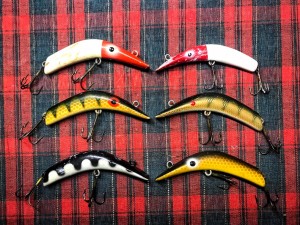
My collection of Lazy Dazy Lures
These things aren’t doing anyone any good locked in a box. While none of them have any real monetary value [there’s millions of these things out there, and they are worth about $5 each to a collector] I would be wildly disappointed if I lost one to a snag or a pike. I’m going to make it a mission to catch some fish on one of these this summer. I can think of a couple of good applications for where I fish nowadays.
I won’t use this perch colored one though. I caught a lot of different fish on it when I was kid and despite using it a lot, I never lost it. It was retired many years ago.
